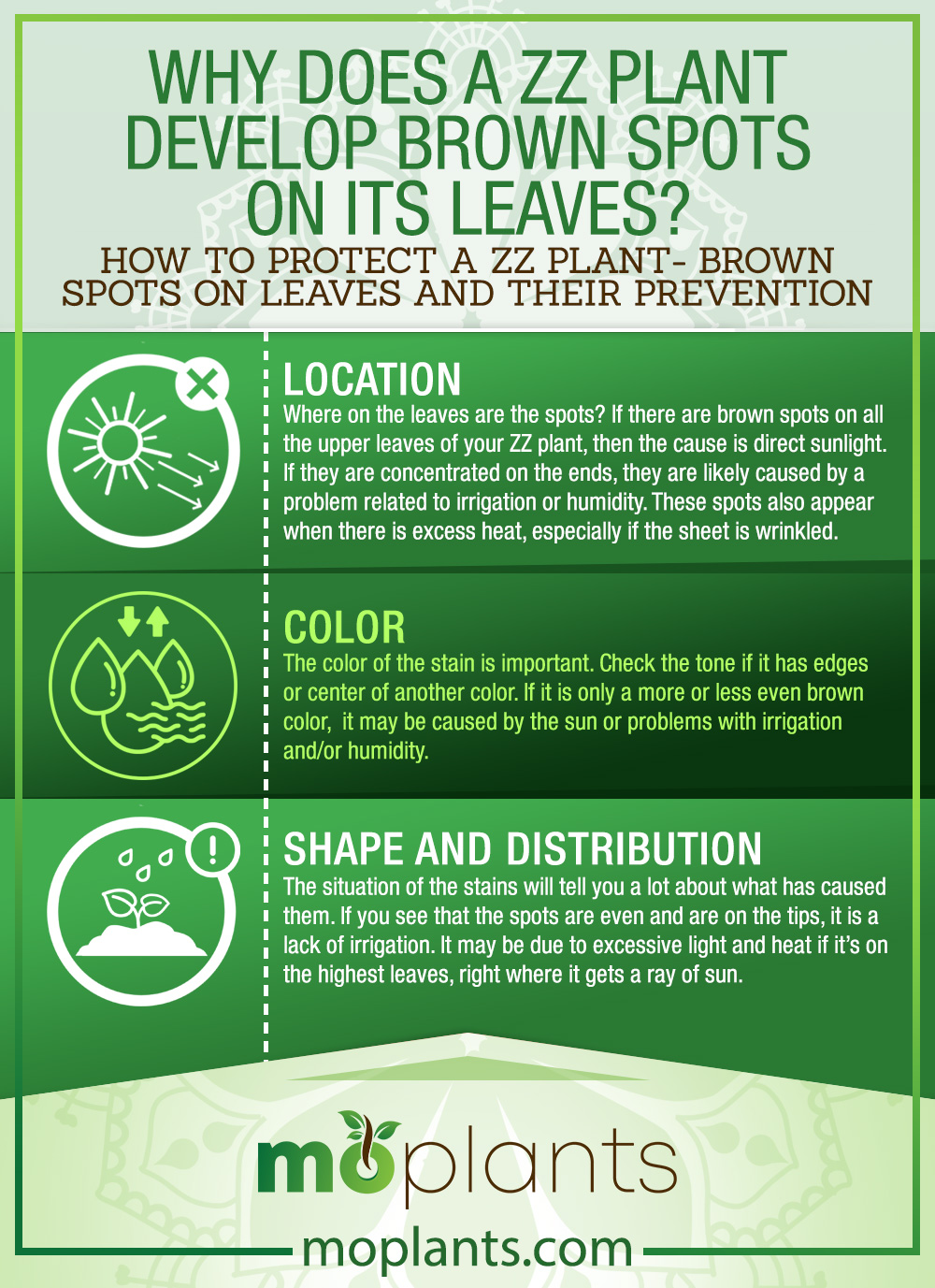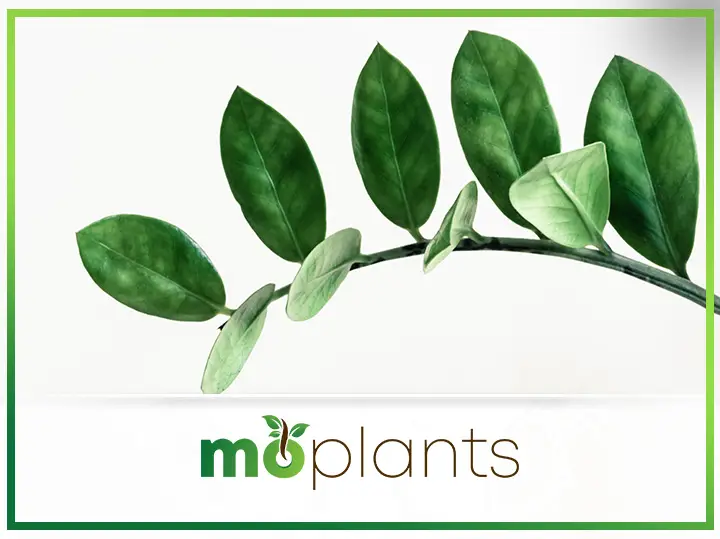- ZZ plant (Zamioculcas Zamiifolia) Trendy Houseplant
- ZZ Plant-Brown Spots on Leaves-Excessive Sunlight
- An Underwatered ZZ Plant-Brown Spots on Leaves
- ZZ Plant- Brown Spots on Leaves Due to Insufficient Ambient Humidity
- How to Protect a ZZ Plant- Brown Spots on Leaves and their Prevention?
- Infographic
- Conclusion!
If you’re an indoor plant lover, you must be familiar with the famous ZZ plant, the hero of the house plant collection for its sturdy nature and broad, attractive, green leaves. Certainly very resistant, the ZZ plant is nonetheless a living being, therefore with its weaknesses. Some parasites can infect it, but most of the diseases, such as brown spots on leaves, are still due to watering and lighting errors in a ZZ plant. Brown spots on leaves of a ZZ plant, on the edges, tips, or the center, are very common but can spread over and affect the entire leaves if left untreated.
But why do these brown spots appear on a ZZ plant? How to prevent them? We will answer all your questions here to provide you with some valuable insights so that you can prevent your ZZ plant leaves from turning brown.
ZZ plant (Zamioculcas Zamiifolia) Trendy Houseplant
Zamioculcas Zamiifolia is an easy-going, robust houseplant that requires little care. Its shiny green foliage brightens up the interior. Originally from Tanzania and Zanzibar, it is more commonly known as the ZZ plant. Although it has been around for centuries, it has gained immense popularity recently and fits every Instagram-worthy picture frame. Scrolling through your Instagram, you surely see thousands of indoor office and home images having this plant.
You don’t have to be an expert gardener to plant and care for this plant. Therefore, if you are a “newbie” in terms of gardening, do not worry because the Zamioculca is extremely resistant and undemanding in terms of cultivation. But, despite this, and like all plant species, its sowing requires special conditions for its development to be optimal.
In its natural environment, the ZZ plant occupies quite diverse habitats. It is found both in the tropical forests of Malawi, where the humidity is high and in Tanzania, where the climate can be dry, followed by a long, rather intense rainy season.
The ZZ plant has therefore learned to resist very different climates, making it a robust and easy-to-grow plant: at the base, it has a tuberous rhizome from which the leaves leave and is capable of storing water during the season. However, it is still affected by some issues, despite its sturdiness to withstand different temperatures and soil. Among the problems affecting a ZZ plant, brown spots on leaves are the most common, mainly because of the lighting issue.
Excess sun and high temperatures cause brown spots to appear that wrinkle the leaves, especially at the tips and edges. Leaves at the top of the plant or where they receive direct sunlight are usually the most affected. Additionally, freezing temperatures can cause leaves to wilt and brownish areas to appear on a ZZ plant as it favors moderate temperatures.
Let’s discuss this further!
ZZ Plant-Brown Spots on Leaves-Excessive Sunlight
Although leaves turning brown can be due to several reasons, a ZZ plant develops brown spots on its leaves mainly due to excess light. Excessive or direct sunlight can dull your plant’s foliage and dry it out. A partial shade exposure may suit it.
A ZZ plant performs well in low-light areas and needs moderate to bright indirect light. Windowless offices, bathrooms, or any indoor space with less light from fluorescent lights are ideal places for a ZZ plant. Brown spots on leaves appear if you put your ZZ plant under intense light.
You may see brown spots or scales on the leaves due to direct sunlight or too much light. Another indication of too much light besides brown spots is the curling of leaves. The best is to keep it in indirect sunlight as it tolerates low light.
The major reason for a ZZ plant to develop brown spots on its leaves is exposure to direct sunlight or excessive light. However, there are some other less likely reasons for brown spots to appear on its leaves.
An Underwatered ZZ Plant-Brown Spots on Leaves
Although the ZZ plant is like a cactus and needs very less water, it can develop brown spots if it is underwatered.
If you witness dry stems, the lower leaves are brown and dry, and the upper leaves are starting to darken from the tips, your plant may be under-watered. However, the symptoms are more or less the same if you overwater it, although the spots and stems tend to turn a little more yellowish. Indeed, excessive watering damages the root of a ZZ plant and impairs its ability to absorb moisture properly.
ZZ Plant- Brown Spots on Leaves Due to Insufficient Ambient Humidity
Although its main enemy is too much moisture, lack of humidity or excessive dryness is as bad for your ZZ plant as it is in extreme humidity.
Most tropical plants need a certain level of ambient humidity to maintain healthy leaves. If the climate is naturally dry or because of air conditioning or heating, it is normal to see brown spots appear on the leaves. They usually start at the edges and then move towards the center. Since their surface is dry, the sheet weakens and cracks easily. A leaf curling up on itself is another characteristic symptom.
Although it happens very rarely, and only extreme dryness can lead to brown leaves, it can be one of the reasons.
Important: If your plant is not mature yet and brown spots appear on it leaves, then it is due to too much direct light or lack of watering. But, if your ZZ plant is adult, leaves turning brown and drying out is normal. This frequently happens in adult subjects. If you want to see your plant start again, we advise you to divide it and keep only the youngest leaves and rhizomes to prevent the old branches from unnecessarily exhausting your plant.
How to Protect a ZZ Plant- Brown Spots on Leaves and their Prevention?
ZZ Plant-Brown Spots on Leaves: Diagnosis
The first step to solving the problem of brown spots on your ZZ plant leaves is to make a proper diagnosis of the causes. Although the most common reason for a ZZ plant to turn its leaves to brown is the excessive sunlight, not all brown spots are the same. So you should take your affected plant, sit with it in a place and carefully observe the spots that have appeared, looking for the following characteristics:
Location
Where on the leaves are the spots? If there are brown spots on all the upper leaves of your ZZ plant, then the cause is direct sunlight. If they are concentrated on the ends, they are likely caused by a problem related to irrigation or humidity. These spots also appear when there is excess heat, especially if the sheet is wrinkled.
Color
The color of the stain is important. Check the tone if it has edges or center of another color. If it is only a more or less even brown color, it may be caused by the sun or problems with irrigation and/or humidity.
Shape and Distribution
It is easy (especially for beginners) to confuse a wilting leaf because it has completed its life cycle with one affected by a problem or disease. Is the spot more round or oval? Is it concentrated in a single section, or does it spread throughout the leaves?
Likewise, the situation of the stains will tell you a lot about what has caused them. If you see that the spots are even and are on the tips, it is a lack of irrigation. It may be due to excessive light and heat if it’s on the highest leaves, right where it gets a ray of sun.
Once you have thoroughly examined your plant and identified the characteristics of the brown spots, you will need to compare them to those that define each of the causes and determine which is responsible for your concern.
Once you determine the cause, it’s time to take the right action.
Infographic

ZZ Plant-Brown Spots on Leaves: What to Do?
If you witness brown spots on the leaves of your ZZ plant, move it away from the window and use thin blinds to filter out excess sunlight. Avoid watering from above and/or at times when the sun is high, as water droplets can act as magnifying glasses and amplify the sun’s rays, causing severe burns.
Place your ZZ plant in the light but not exposed to direct sunlight. Prefer a window facing east or west. It is a fact that the ZZ plant does not fear slightly dark environments, but for its growth, it needs light. Adapt to its needs by bringing it closer to the light when a sprout is developing. Remember that the amount of light decreases drastically as soon as you move just a little away from the source.
This raises another question: Can my ZZ Plant Grow in a Dark Corner? Well, the ZZ plant appreciates the light. It can adapt to a less illuminated corner but not a very dark one. It is best to place it in a corner with enough light. If it does not have enough light, it will elongate the branches, and they will grow loose and weak, which will lead them to sag. It is also important not to be exposed to direct sunlight, as brown spots appear on its leaves.
Protect it from strong winds and frost. Avoid placing it where drafts are common, such as near doors and windows.
Also, pay attention to their position. Try not to crowd them too much and ensure the leaves don’t touch the walls, as this contact can also lead to stains and other inconveniences.
Now you know why you see brown spots on your ZZ plant. Brown spots on leaves of your ZZ plant are not harmful, but they are a sign that you need to move your plant to a darker place.Indeed, a ZZ plant is a favorite indoor plant because of its resistant nature, and following some simple tips and techniques can help in its growth and health, and you get shiny green leaves in your space all year long.
Conclusion!
To sum it up, do not place your ZZ plant in excessive sunlight to prevent brown spots from appearing on its leaves. Place it in a place with moderate light. Moreover, brown spots may also indicate that you’re underwatering your ZZ plant or the humidity level is too low, causing the leaves to dry. With some simple steps, you can maintain your ZZ plant’s health.
It is true that, in many cases, these brown spots do not directly endanger your ZZ plant life because they do not attack the roots. But, they affect the green surface of the leaf, where the vital process of food synthesis begins. Therefore, it is essential to diagnose and fix this problem.
If you’re interested in more information about the tips on how to grow, care and maintain plants belonging to different species and types, connect with us at Mo Plants. We are a one-stop gardening directory for all gardening enthusiasts and an excellent source of knowledge and comprehensive guides on plants, vegetables, herbs, and fruits.

